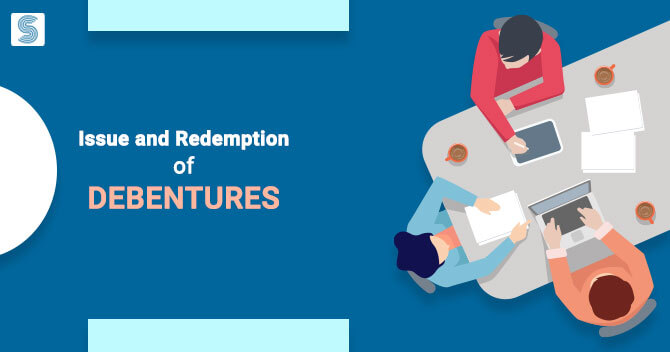Issue and Redemption of Debentures – Problems and Solutions

Dashmeet Kaur | Updated: Jan 11, 2020 | Category: SEBI Advisory
Shortage of funds is inevitable while running any business regardless of its size. Moreover, a single financial institute cannot suffice the requirement of a large sum of money. Therefore, a company relies upon multiple methods of raising funds rather than clenching onto the traditional lenders like banks. One such efficient mode of fundraising is the issue and redemption of debentures. This blog will focus on both the terminologies of issue of debentures and its redemption. Also, it will highlight the challenges in regards to debentures and how you can get through it.
Table of Contents
What is the Issue of Debentures?
A debenture is a debt instrument which acts as evidence of the loan which a company owes to the public. It is a kind of debt that has a fixed-interest bearing cost. A debenture is a written undertaking of the company’s liability to pay a fixed rate of interest either monthly, half-yearly or annually. Further, the debenture also comprises of the terms of conditions related to the issue and redemption of debentures. It explicitly lists all the information of loan such as the interest rate, loan amount, maturity date, etc.
Browse through our articles on services provided at Swarit Advisors, and just let us know if we can help you with your IPO or Comapny Takeover or SEBI Advisory Services.
A Brief about the Redemption of Debentures
Redemption is the repayment of a debenture’s amount to the debenture holder or creditor. For instance, if a company is about to get diluted, then it is liable to clear off its debenture and pay all the loans by selling its assets or through the general reserve. Once the creditor redeems the debenture from an enterprise thereon, it discards the liability and removes it from the balance sheet. Generally, in the redemption of debentures, one has to pay a hefty amount. Thus, it’s wise to make sufficient provision out of the profits and gather funds to redeem debentures.
Statutory Provisions Regulating the Issue and Redemption of Debentures
Section 71 of the Companies Act, 2013 regulates the issue and redemption of the debenture. Let’s take a look at the provisions which one has to compel with while choosing the fundraising scheme of debentures:
- An enterprise may issue debentures with an option to convert it into equity shares either wholly or partially at the time of redemption. The conversion can only take place a Special Resolution passed in a general meeting.
- Under Section 71 of Companies Act, for the issue and redemption of debentures, a company shall create a debenture redemption reserve account. The account shall incur from the profits of the company to pay dividends. Besides, the credited amount in the reserve account can only be utilized during the redemption of debentures.
- A company must pay interest and redeem the debenture as per the terms and conditions of the issue of debentures.
- If a debenture trustee culminates that the assets of the liable company are insufficient to pay off the debenture’s amount, thereby he can file a petition before the Tribunal. After that, the Tribunal hears the company justification or any other person interested in the matter. Tribunal may take necessary actions to safeguard the interest of debenture holder.
- In case the company breaches any order of the Tribunal, every officer of that company shall be punishable with imprisonment. The period of imprisonment may extend to three years. Also, the company may have to pay a fine of at least two lakh rupees that can reach up to 5 lakh rupees. Further, in extreme situations, the defaulter company has to bear both imprisonment and fine.
Guidelines to follow under Section 117 C of Companies (Amendment) Act, 2000
Here is the list of norms that every company needs to abide in the issue and redemption of debentures:
(i) Every company shall create Debenture Redemption Reserve (DRR) in case of the issue of debentures redeemable after more than 18 months from the date of issue.
(ii) While issuing non-convertible debentures and a non-convertible portion of partly convertible debentures a company must create DRR.
(iii) A company shall create DRR in proportion to 50% of the issued debenture’s amount before commencing the redemption of a debenture.
(IV) A company can only withdraw from DRR after 10% of its debenture liability has been redeemed by the debenture holder.
What are the Sources of Funds for the Redemption of Debentures?
A company has two options for the redemption of debentures which are as follows:
- Redemption of Debentures out of Capital: In this method, the company may discard some of its fixed assets and utilize the sale proceeds to redeem the debentures. Though often companies do not opt for this source of finance as it seems to be a bit unusual. Other than that, companies also prefer to utilize their working capital for the redemption of the debentures. However, it will adversely affect the working capital of the company.
- Redeem a Debenture out of Profits: It implies that an amount equivalent to the face value of the redeemable debenture is transferred to DRR. Hence, a portion of the company’s profit gets withheld from distribution to the shareholders.
Terms of Issue and Redemption of Debentures
The redemption of a debenture depends on the terms of its issue. Here are the three different ways of issue of debentures:
The issue at Par: Under such an issue, the debentures are redeemable at their nominal value/ face value. The company can either make a one-time payment or in installments. When a company issues debenture at par, the liabilities column of Balance Sheet is equal to the asset side. Thus there is no need for any adjustments.
The issue at Premium: In the premium issue, the redemption is at a higher value than the nominal value of debenture. The repayment of such redemption results in a capital loss of the company. Although the company pays a premium amount during redemption, it is displayed as liability from the start of the issue.
At a Discount: It is a theoretical concept wherein the debentures are redeemed at a lower price than the face value of debenture.
Conclusion
Also, Read: What are the Different Types of Debentures?.














